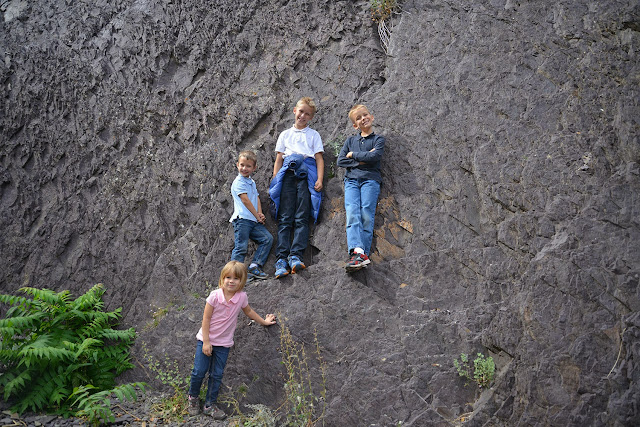We spent a couple days focusing on sedimentary rock. There was a lot to cover because we studied fossils along with it. This first activity shows how sedimentary rock can be formed with heat and pressure. First, you smash up graham crackers in a bag (this represents weathering of larger rocks into sediment). Add a bit of sugar (this represents other types of sediment mixing with the earlier kind). Then you pour melted butter over the sediments (the butter represents mineral-rich water flowing through the sediment. The minerals will help cement the sediment together as it hardens).
Press your sediment into an oven-proof dish (we did individual sizes). This represents compacting. Then bake it in the oven at 425 for 5-8 minutes.
Hopefully, this will give you a "sedimentary rock" you can hold and eat! More butter (minerals) will give you a more cohesive rock. It's pretty fragile, though, so hold it carefully!
Another day, we made these "sedimentary layer bars" (recipe here, but you can adapt it---it's just a graham cracker crust, and then you layer any kinds of baking chips, nuts, coconut, etc. on top, and pour sweetened condensed milk over the whole thing). We pretended the graham cracker was compacted sand, the chips were fossils, the coconut was silt, and the sweetened condensed milk was clay and water that hardened over the whole thing to cement the rock together.
This next activity shows how nodules and geodes are formed in sedimentary rock. [A nodule, if I understand it right, happens when the mineral matter forms around a mineral lump in the rock. A geode happens when the minerals seep into a cavity.] In igneous rock, geodes are formed by gas bubbles inside of magma. The bubbles harden and minerals seep into the cavity left, then crystallize there. That's the only type of geode I'd ever heard of before, but they can form in sedimentary rock too! In sedimentary rock, the process usually starts with a dead animal in its burrow, or a tree root, that makes a "bump" in the sedimentary layers. Over time, the organic matter decays and leaves a hollow space behind, since the rock has already hardened around the bubble. Then, as in igneous rock, mineral-rich water can seep into the cavity, and the minerals form crystals over time.
I had a perfect way to demonstrate this process, but I first heard of this activity as an Easter object lesson to show The Empty Tomb---so I felt a little bit like I was being sacreligious by making it into an activity about geology. But then, as Sam reminded me, marshmallows do not actually have any connection with Jesus' body, so I decided it was okay. :) (I still do think this is a nice activity to do for Easter and the Empty Tomb, so we may "resurrect" it [HA!] next year.)
Here is the activity:
1. You roll a marshmallow in melted butter and cinnamon sugar. This marshmallow represents a poor little dead animal. Perhaps a bunny. One that died a natural, painless death from old age.
2. Set the marshmallow on the wide end of a section of refrigerated crescent roll dough, and roll it up. Pinch the ends of the crescent roll dough around the marshmallow until it's completely covered. This represents the layers of rock and mineral that get deposited on top of the animal's burrow over time. (You can sprinkle cinnamon-sugar on the outside of the rolls too, if you want---like more sediment being added.)
3. Put the rolls onto a greased baking sheet and bake them at 375 for 13-15 minutes. This represents eons passing!
4. When the rolls come out of the oven, let them cool just for a minute, then bite into them. The "animals" have disappeared, leaving an empty hole behind! You can look in and see the "mineral crystals" (cinnamon sugar) beginning to form inside the hole.
Geode roll!
There are huge deposits of this bluish-purplish and greenish shale all along the road. It was once under an ancient sea, and you can still see marks in the rock from the ripples in the waves. It is really beautiful!
I love the colors.










No comments:
Post a Comment